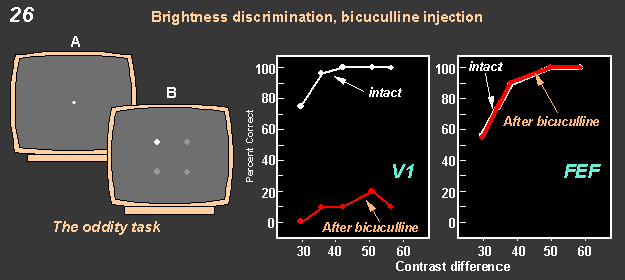The Neural
Control of Visually Guided Eye Movements
C. Cortical Mechanisms of Visually Guided Saccadic Eye Movements
To further assess the effects of bicuculline in these two areas, we
examined the monkey's ability to make visual discriminations. This is
shown in Figure 26. A brightness
discrimination was used as previously described, with one target centered
within the visual or motor field of the neurons injected. The degree of
luminance difference between the target and comparison stimuli was systematically
varied. Injection of bicuculline into V1 produced a major deficit in V1
but had no effect in the FEF.

It appears therefore that the role of GABAergic neurons in V1 and the
FEF is quite different. In V1, inhibitory circuits are essential for processing
information about the nature of visual stimuli. Release from inhibition
does not result in increased neuronal activity in the cortico-tectal cells
that reside in layer 5 of V1 that under normal conditions play a role
in initiating saccades through the superior colliculus. By contrast, in
the FEF, release from inhibition as the result of the bicuculline injection
results in an increase in the signals sent downstream for eye-movement
generation without affecting the ability to discriminate the visual stimuli.
|
